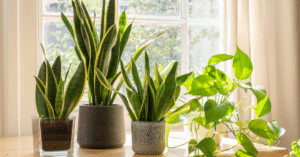Moving beloved houseplants in the dead of winter, a task often referred to as “winter houseplant transport,” can be doubly stressful! As an experienced gardener with a few “Winter Plants Moving” fiascos under my belt, I’ve since mastered the careful strategies required for indoor plant relocation in winter.
In this comprehensive guide, you’ll find essential tips for moving plants during the colder months to ensure your leafy friends are safely and efficiently transported during the colder months.
Through trial and error (mostly error), I eventually mastered the art of moving green friends in cold weather. Whether transporting a few pots across town or an entire conservatory collection to a new home, my comprehensive winter plant moving guide covers everything.
You’ll learn specialized tips to ready delicate ferns or towering palms, pack the moving van to protect greenery, adjust watering at critical moments, and much more. Follow this advice, and your plants and you will flourish in your new abode come springtime! So, let’s get right into winter plant prep…
Key Takeaways: We've Got You Covered!
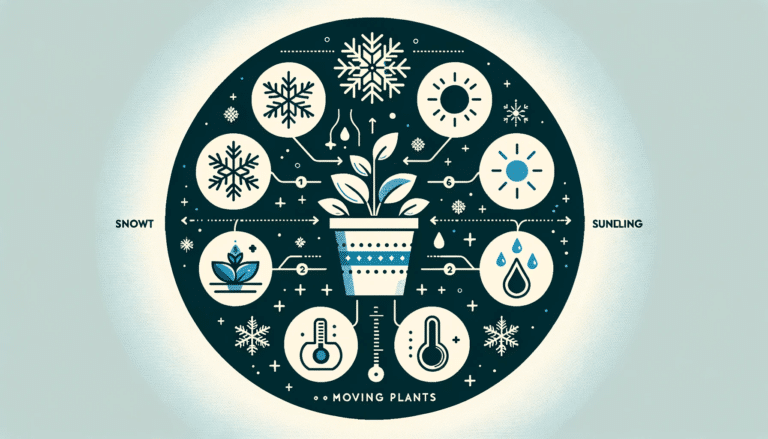
1. Prep Guidance – This guide, essential for winter houseplant transport, covers critical pre-move plant preparation like pruning, pest checks, and watering adjustments to set your greenery up for success.
2. Protection Pointers – You’ll learn pro tips for insulation, heating aids, secure vehicle loading, gentle driving and more for keeping plants safe.
3. Smooth Transitioning – Find step-by-step unpacking/positioning advice focused on gradually acclimating plants and preventing shock as they adapt.
4. Troubleshooting Included – We tackle what to watch for post-move to spot problems early, dealing decisively with any transplant or cold stress challenges that emerge.
5. Ongoing Care Regimes – Tailored recommendations help each plant uniquely thrive long term in new environments using ideal fertilization, soils, sunlight calibration and beyond!
How to Prepare Your Plants for Moving Day?
Understanding the nuances of indoor plant relocation in winter, let’s delve into key preparation tips and cold weather plant moving tips before packing day arrives.

Assessing and preparing each plant
- Thoroughly inspect all houseplants – check for pests or signs of stress, and address any issues, following the latest research on plant stress during relocation. This prevents problems worsening during transit.
- Prune back overgrown plants so branches don’t break while loading the moving van or jostling in the car.
- Group plants with similar light and watering needs. This streamlines transport and post-move positioning.
Pruning and watering strategies pre-move
- Avoid drastic pruning or propagating right before moving day – it adds unnecessary stress.
- Alter regular watering schedules to control moisture levels:
- Water thoroughly 1-2 weeks pre-move. This maximizes hydration.
- Gradually reduce watering closer to moving day. Overwatering risks root rot while plants are in dark, cramped transit.
- On moving day itself, check soil moisture and water each plant sparingly. The goal is damp but not saturated soil during packing and transport.
What Are the Best Ways to Pack Your Plants?
When preparing to pack up your potted plants for a winter move, use these top techniques to keep them secure and protected:
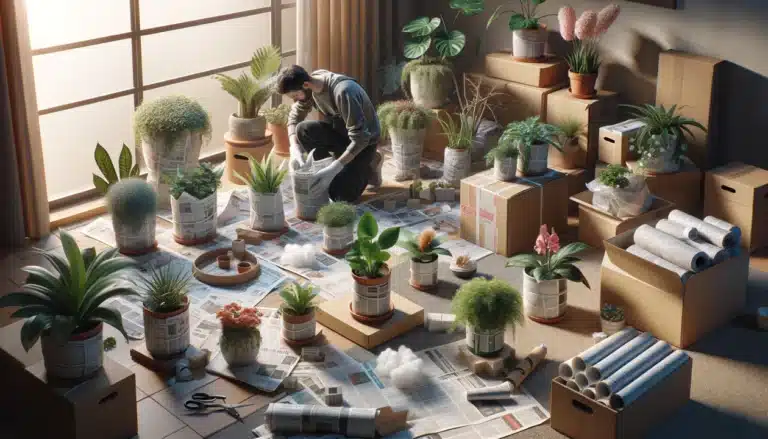
Selecting the right materials
- Newspaper or packing paper gently cushions plants and insulation materials inside boxes. Use several sheets for ample padding.
- For delicate plants, wrap pots in bubble wrap for added shock absorption. Popcorn can also work in a pinch.
- Cardboard boxes make excellent plant shipping containers – just cut ventilation holes. Line them with newspaper for cleanliness.
- To stabilize tall or heavy plants, string or tape them to sturdy cardboard or wood supports. This prevents toppling.
Techniques for packing different types of houseplants
- For bushy or sprawling plants, carefully secure all extending branches before packing around the pot with newspaper.
- Pack climbing plants vertically, providing rigidity with stakes or plant-safe structure inside the box.
- Protect fragile flowers by tenting tissue paper over the blooms before wrapping with newspaper at the stem base.
Mix and match these packing supplies and methods to create safe transit homes for your plants. Stay tuned for insulation tips to protect them from the cold next!
Insulating Your Plants: How to Protect Them from the Cold
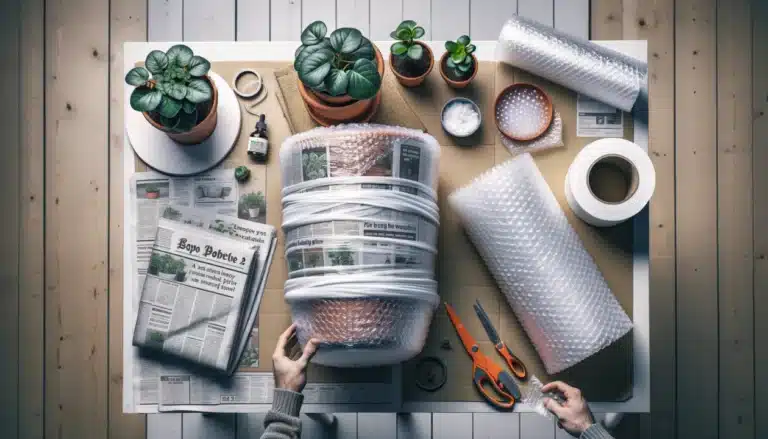
In addition to careful packing techniques, a crucial aspect of cold weather plant moving tips includes insulating your potted plants to guard against temperature drops.
DIY insulation methods for plant pots
- Start with dry newspaper or packing paper, a method detailed in DIY insulation methods for plants around the bases of pots to retain heat. Add layers to increase warmth, securing paper with twine or tape.
- Line entire moving boxes with 1-2 inches of tightly packed newspaper or bubble wrap before loading plants. The density traps heat.
- For houseplants requiring tropical conditions, fill interior box space with polystyrene foam pieces or shredded paper to create a DIY “cooler” protecting plants.
- When transporting plants in open vehicles/trucks, rig blankets over the bed area to mitigate wind exposure. Secure tightly.
Professional insulation products
- Seek thick, waterproof, high-R value plant sleeves for individual pots, keeping soil warmth stabilized. Cloak larger containers in insulating plant blankets.
- Invest in insulated shipping boxes designed specifically to transport plants through cold zones – these allow for airflow while maintaining ideal inner temperature range.
- For extreme cold, utilize plastic thermal plant containers aka nursery “hot boxes” – they seal closed like coolers to keep contents well above freezing and block wind.
Additional tips for DIY and professional methods
- Monitor internal box or vehicle temperature with a thermometer, adding/adjusting insulation constantly to avoid dips below 40° Fahrenheit during the move.
- Include microwavable hand/foot warmers inside boxes and vehicle cabs as portable heat sources supporting insulation.
- Once plants are positioned inside insulated boxes or vehicles, fill remaining gaps with more loose insulation like packing paper or blankets to prevent cold air intrusion.
Transporting Your Plants: What Vehicle Should You Use?
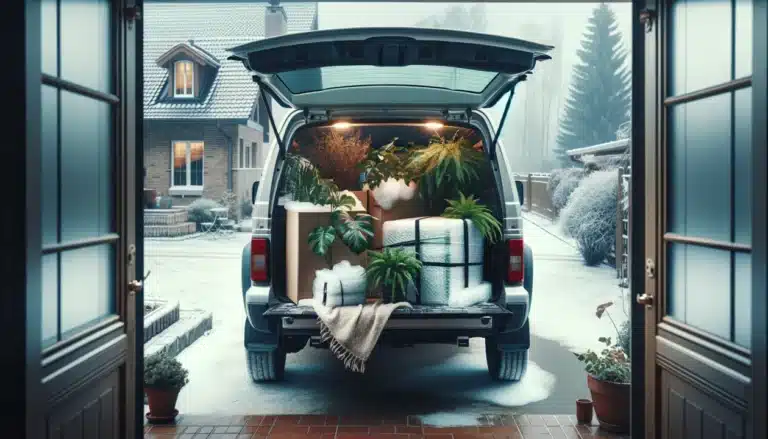
Selecting the right vehicle is pivotal in winter houseplant transport, ensuring your houseplants remain happy and healthy during their winter journey.
A car with functioning heating can maintain an adequate interior environment for short local relocations. During more lengthy journeys, enclose plants inside climate-controlled moving vans that shelter greenery while insulating against unpredictable cold outdoor conditions.
Professional specialty movers also offer temperature-regulated trucks for transporting delicate items like plants during extreme weather. And don’t forget – the vehicle is only part of the equation!
Securely clustering plant cargo by size and anchoring each pot while positioning them away from climate control vents prevents hazardous shifting and exposure during drives.
Keeping Plant Passengers Safe and Snug

Picture this: It’s moving day, and you just finished loading the last insulation-wrapped pot into the van. As you slide behind the wheel for the long haul to your new home, glancing back at your leafy cargo, vital questions surface…
Is the temperature comfortable in there?
Did I overwater them today?
What road hazards might endanger these precious plant passengers?
As an experienced plant relocation captain, I must anticipate and address all such transit concerns. By following my winter houseplant transportation commandments below, you’ll guarantee clear sailing as well:
Monitor Temps Vigilantly
Outfit each boxed plant area with tiny thermometers to monitor plant health during transport. Target 40-75° Farenheit for tropicals, and avoid extended sub-40° exposure. Have microwavable hand warmers at the ready inside boxes and vehicle cabin to maintain warmth.
Water Warily
Err on the side of underwatering pre-transit to limit soil leakage or spills inside dark, jostling boxes which can spawn root rot. But don’t let plants totally dry out either.
Drive Gently Over Bumpy Roads
Cautious speeds and smooth maneuvers prevent excessive sloshing of soil or fraying of fragile branches. Cushion trucks and trailers with blankets for further jostle protection.
Adhere to these best practices for in-transit plant wellness, and your green family will arrive thriving and unstressed in their exciting new habitat! Time to unpack carefully…after a few deep breaths, of course.
New Home, New Start: Welcoming Plants Smoothly

You’ve finally clutched that shiny new house key…but have your beloved plants in tow too, worlds away from everything familiar. Help them recuperate swiftly and launch robustly into this foreign habitat by following my expanded plant arrival advice:
Temperature Regulation
Before unpacking, assess microclimates, create a suitable microclimate for houseplants in potential new plant spaces, and seek bright, protected areas away from drafty doors/windows or searing radiators. Monitor temperatures daily. Add grow lights, fans, and space heaters to fine-tune.
Acclimate Gradually
Allow plants weeks to adjust to environmental shifts, slowly transitioning them via spaced-out exposure sessions rather than sudden, shocking changes. Move plants incrementally closer to permanent positions over 14-30 days.
Water & Prune Judiciously
Inspect plants closely as you unpack, making conservative trims if needed and watering lightly following inspection. Significantly increase hydration only after acclimation period once plants show readiness via healthy new growth in their new positions.
Quarantine Recent Additions
Isolate freshly acquired greenery away from original plant population for 1 month+, carefully checking for emerging pest/disease issues which spread rapidly during moves.
With this expanded guidance for major plant care categories post-move, your green family flourishes beautifully in their new paradise! Time to relax with them…after the long-awaited housewarming party, of course!
How to Ensure Your Plants Flourish in Their New Location?

Relocated houseplants require tailored care for relocated houseplants to thrive long-term in new environments. Here are tips:
Optimize conditions
Observe how each plant interacts with it’s new surroundings: light, humidity, airflow etc. Make adjustments via soil quality improvements, fertilizer regimes, propagation, specialized potting mixes to suit the plant’s needs in its new home based on your assessments over the first month.
Bond through observation
Inspect plants closely each day, feeling for moisture levels, scanning for pest/disease signs, monitoring growth cues, leaf color changes and more. Consider journaling daily plant thoughts! This expands awareness of individual plant needs, helping provide customized flourishing care.
Shuffle if necessary
Experiment with placing plants in different locations of the new space if challenges emerge, seeking the sweet spots that offer each plant exactly what it wants to explode with vitality whether that’s brighter light, higher humidity, more shelter from drafts or less. Let them guide you to their favored zones!
Can You Use a Moving Company for Plants? Pros and Cons
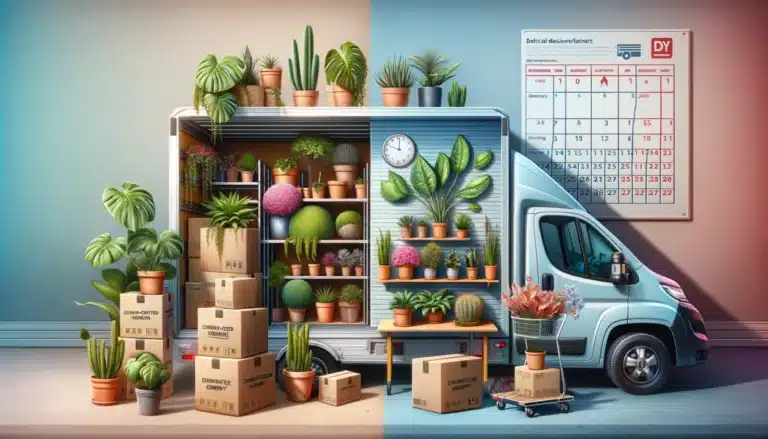
Is it wise to let professional movers transport precious houseplants rather than going the DIY route? Consider key factors:
| Pros | Cons |
|---|---|
| Climate controlled vehicle | Risk of rough handling from non-specialists |
| Less physical strain | Higher costs apply on top of moving expenses |
| Quicker transit, less boxed time | Potential delays behind household goods |
Trusted plant specialty moving companies with excellent service reputations may warrant the splurge for far-away/large-scale relocations. But hobbyists moving locally are likely okay with handling plant transport independently by following best practices!
Keep Calm and Carry On (Winter Plant Moving)
Like so many daunting endeavors life throws our way, relocating beloved houseplants in chilly conditions can feel overwhelming before it begins.
But by methodically tackling critical preparation checkboxes – from assessing plant health weeks prior, to smart packing techniques day-of, to gradual acclimation in the new location upon arrival – the prospect shifts from nerve-wracking to smoother than imagined!
While occasional plant parent panic still sneaks up even for seasoned experts like myself, rest easier knowing you now have an expanded winter plant moving toolkit.
Revisit the guidance herein anytime pre-move jitters surface. And remember, your green friends want to thrive in their exciting new realm as much as you do in your fresh abode this coming spring!
Frequently Asked Questions
How do you transport houseplants in the winter?
Use enclosed trucks/vans with climate controls. Cluster plants by size with protective materials securing against interior jostling during drives. Monitor boxed plant temperatures using thermometers and heat packs.
How do you pack indoor plants for moving?
Start by pruning plants for transport and tending to any pest issues if needed. Carefully pack pots with newspaper/bubble wrap in cardboard boxes. Water lightly before packing day to prevent soil shifting & root rot.
How do you keep plants alive while traveling?
Avoid direct cold air exposure when packing vehicle. Position plants away from vents and frequently check boxed plant temps during trip. Keep microwavable warmers inside and a blanket or insulation barrier behind truck cabs.
What materials should I pack around potted plants?
Crumpled newspaper surrounding pots absorbs moisture and insulates plant roots. Top off boxes with added newspaper, packing paper, bubble wrap or shredded paper around the plants.
Should I hire pros movers or go DIY?
Trusted plant specialist movers worthwhile for far-away/large relocations to leverage temperature controlled vans. But hobbyists moving locally likely can transport plants independently by applying best practices.
Sources
https://www.ncbi.nlm.nih.gov/pmc/articles/PMC8838314/
https://laidbackgardener.blog/2020/12/10/moving-houseplants-in-winter/
https://pubs.acs.org/doi/10.1021/acsomega.0c05850
https://www.bhg.com/gardening/houseplants/care/houseplant-care-guide/










